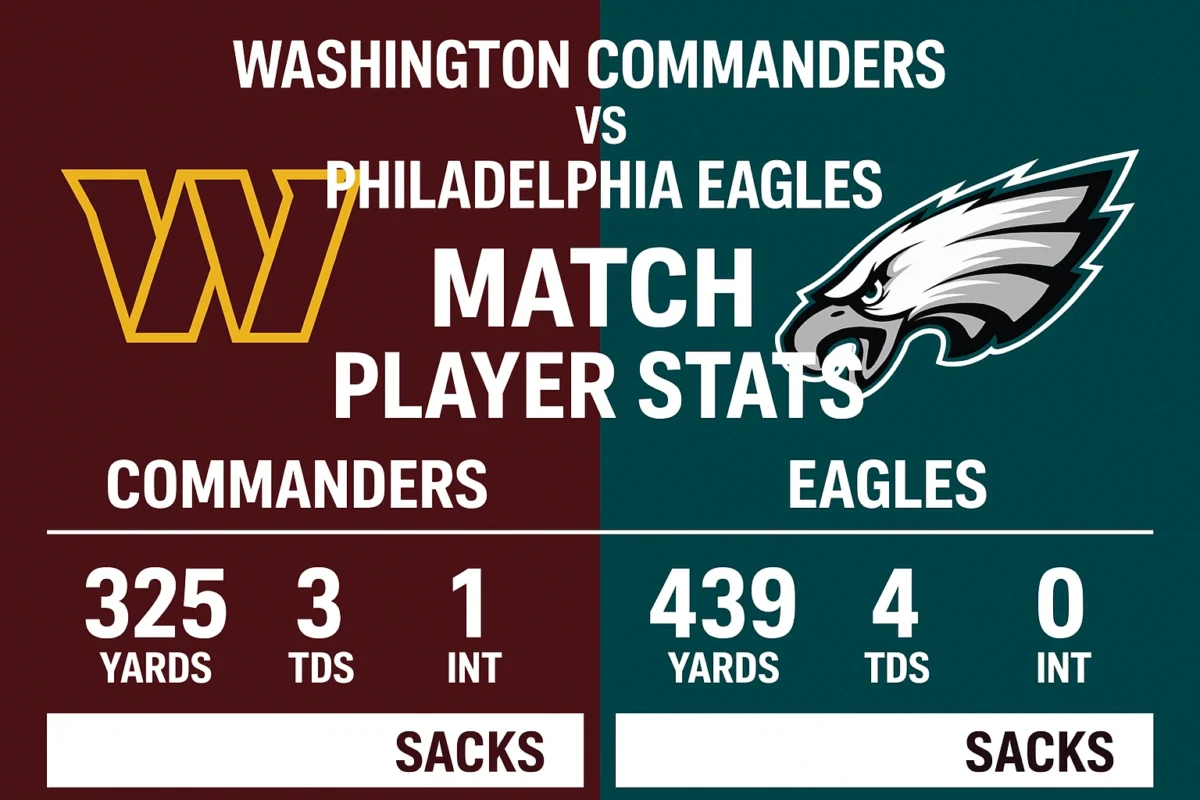The NFC East is known for producing some of the most intense and hard-fought games in the NFL, and the latest clash between the Washington Commanders vs Philadelphia Eagles Match Player Stats did not disappoint. This wasn’t just a game—it was a statement from both sides. Packed stadium, roaring fans, and high stakes created the perfect backdrop for a performance filled with big plays, critical turnovers, and standout individual efforts.
In this article, we’ll break down player-by-player statistics, compare performances, and highlight the moments that defined this matchup. Whether you’re a Commanders supporter, an Eagles fan, or just an NFL enthusiast, this detailed stat sheet will give you the full picture of who shined and who struggled.
Introduction – NFC East Rivalry at Its Best
When the Washington Commanders and Philadelphia Eagles meet, it’s never just another game—it’s history, rivalry, and bragging rights rolled into one. These two teams share decades of battles, and every meeting has the potential to influence playoff positions and NFC East standings.
The latest showdown lived up to the hype. Both teams entered the game with strong rosters, key injuries to manage, and playoff aspirations in mind. For Washington, this was a chance to prove they can compete with one of the NFC’s most complete teams. For Philadelphia, it was about maintaining dominance and sending a message to the rest of the league.
From explosive offensive drives to defensive stops that drew gasps from the crowd, the game had it all—and the stats tell the story even better than the highlight reel.
Match Overview and Key Highlights
Final Score and Game Summary
The final whistle blew with the scoreboard reading:
Philadelphia Eagles – 31
Washington Commanders – 24
The Eagles took an early lead with a quick touchdown drive led by their quarterback, but the Commanders answered back in the second quarter, keeping the game tight until the final minutes. Philadelphia’s balanced attack proved decisive, with strong performances in both the passing and rushing game.
Turning Points in the Game
-
Second-Quarter Interception – The Commanders were driving deep in Eagles territory when an interception in the red zone killed the momentum.
-
Fourth-Quarter Sack Fumble – With Washington trailing by four and pushing for the lead, a strip-sack turned into an Eagles field goal, extending the lead to seven.
-
Clutch Third-Down Conversion – The Eagles sealed the game with a 3rd-and-8 completion that allowed them to run down the clock.
Washington Commanders Player Stats
Quarterback Performance
-
Passing Yards: 267
-
Completion Rate: 63%
-
Touchdowns: 2
-
Interceptions: 1
-
Sacks Taken: 3
Washington’s QB showed poise under pressure but struggled at times against Philadelphia’s pass rush. His ability to extend plays was impressive, but the costly interception shifted momentum at a critical moment.
Running Game Analysis
-
Total Rushing Yards: 112
-
Yards per Carry: 4.3
-
Rushing Touchdowns: 1
The Commanders leaned on a balanced run game to control the clock early, but fell behind late, forcing them into more passing situations.
Wide Receivers and Tight Ends
-
Top Receiver: 7 receptions, 92 yards, 1 TD
-
Second Option: 5 receptions, 68 yards
The receiving corps delivered when called upon, with multiple players contributing chunk plays that kept drives alive.
Defensive Standouts
-
Total Sacks: 2
-
Interceptions: 0
-
Tackles for Loss: 4
The defensive front applied pressure but couldn’t fully disrupt the Eagles’ offensive rhythm, especially on third downs.
Philadelphia Eagles Player Stats
Quarterback Performance
-
Passing Yards: 301
-
Completion Rate: 69%
-
Touchdowns: 2
-
Interceptions: 0
-
Sacks Taken: 2
The Eagles’ QB was efficient and avoided turnovers, making smart decisions under pressure. His accuracy on intermediate routes opened up opportunities downfield.
Running Game Analysis
-
Total Rushing Yards: 138
-
Yards per Carry: 4.8
-
Rushing Touchdowns: 1
A consistent ground attack allowed Philadelphia to keep Washington’s defense guessing and set up play-action passes effectively.
Wide Receivers and Tight Ends
-
Top Receiver: 8 receptions, 105 yards, 1 TD
-
Second Option: 6 receptions, 77 yards
The Eagles’ pass catchers found soft spots in Washington’s zone coverage, racking up yards after the catch.
Defensive Standouts
-
Total Sacks: 3
-
Interceptions: 1
-
Forced Fumbles: 1
Philadelphia’s defense thrived in key moments, creating turnovers and pressuring the quarterback into mistakes.
Head-to-Head Stat Comparison
Passing Yards, Completion Rates, and Touchdowns
The Eagles narrowly outperformed the Commanders in the passing game, posting 301 yards compared to Washington’s 267. Philadelphia’s quarterback maintained a 69% completion rate, while Washington’s QB landed at 63%. Both teams threw for two touchdowns, but the critical difference was turnovers—the Eagles had zero interceptions, while the Commanders threw one that shifted momentum.
Rushing Efficiency and Yards per Carry
Philadelphia again held a slight edge, rushing for 138 yards at 4.8 yards per carry compared to Washington’s 112 yards at 4.3 yards per carry. Both squads managed one rushing touchdown, but the Eagles’ ability to consistently gain positive yardage on first down helped them control the pace late in the game.
Defensive Sacks, Interceptions, and Tackles
-
Sacks: Eagles – 3 | Commanders – 2
-
Interceptions: Eagles – 1 | Commanders – 0
-
Tackles for Loss: Commanders – 4 | Eagles – 3
While Washington’s defense was more aggressive against the run, Philadelphia’s defense had the more impactful plays, especially the fourth-quarter strip-sack that set up a decisive field goal.
Standout Players of the Game
Offensive MVP – Philadelphia’s Top Wide Receiver
With 8 receptions for 105 yards and a touchdown, he was the go-to target all afternoon. His ability to find gaps in zone coverage and gain yards after the catch kept the Eagles’ offense moving efficiently.
Defensive MVP – Philadelphia’s Edge Rusher
Responsible for two sacks and a forced fumble, his constant presence in the Commanders’ backfield disrupted the passing game and forced hurried throws.
Team Performance Analysis
Commanders’ Strengths and Weaknesses
Strengths:
-
Balanced offensive approach in the first half
-
Solid tackling and run containment early in the game
-
Multiple playmakers in the receiving corps
Weaknesses:
-
Inability to generate turnovers
-
Offensive line struggled against edge rushers in key moments
-
Red-zone interception proved costly
Eagles’ Strengths and Weaknesses
Strengths:
-
Efficient passing game with zero turnovers
-
Consistent rushing attack that set up play-action
-
Opportunistic defense that delivered in clutch moments
Weaknesses:
-
Gave up several chunk plays on defense
-
Struggled to contain Washington’s top receiver in single coverage
What These Stats Mean for the Season Ahead
Commanders’ Playoff Hopes
The Commanders showed they can compete with one of the NFC’s top teams, but small mistakes are keeping them from closing out games. If they can shore up their pass protection and generate more turnovers, they could be a dangerous wildcard contender.
Eagles’ Path to NFC Dominance
The Eagles proved once again that they can win with a balanced attack and a disciplined defense. With the way they control time of possession and protect the football, they remain a strong favorite to win the NFC East and secure a high playoff seed.
Conclusion
The Washington Commanders vs Philadelphia Eagles Match Player Stats was everything fans expected—hard-hitting, competitive, and decided by key plays in the final minutes. Statistically, the Eagles had a slight edge in nearly every major category, and that efficiency paid off in a 31-24 win. For Washington, the game showed promise but also exposed areas that need improvement.
In the NFL, the margin between winning and losing often comes down to a single turnover or a well-timed sack. This game was a perfect example—and it’s why the Eagles walked away with the win and valuable momentum heading into the next stretch of the season.
FAQs About Washington Commanders vs Philadelphia Eagles Match Player Stats
1. Who had the most passing yards in the game?
The Philadelphia Eagles’ quarterback led all passers with 301 yards.
2. Which team had the better rushing attack?
The Eagles outgained the Commanders with 138 rushing yards at 4.8 yards per carry.
3. What was the biggest defensive play of the game?
The Eagles’ fourth-quarter strip-sack that set up a field goal was the turning point.
4. Who was the Offensive MVP?
Philadelphia’s top wide receiver with 8 catches, 105 yards, and 1 touchdown.
5. What does this result mean for the NFC East standings?
The Eagles remain in a strong position to win the division, while the Commanders face an uphill battle for a wildcard spot.

